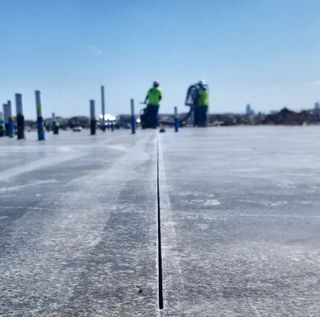Control Joints To Prevent Concrete Cracking
As most in construction know, concrete cracks as it shrinks during the curing process. This is inevitable. But, you can help determine where the cracks will appear by cutting control joints.
Early Entry Saws vs. Flat Saws
A contractor has two tools to choose from when ordering the saw cutting of control joints in their green concrete: an early-entry saw (also known as soff-cut) or a flat saw. The two main differences between these are the use of water and the move-on time.
An early-entry saw is able to do just that -- move on to the slab earlier than that of a conventional flat saw. With less weight, wider wheels, and skid plates that attempt to prevent raveling of the edges, early-entry saw cutting often holds the advantage over flat saw cutting with its ability to move onto a slab as early as one hour after finishing. In addition to its ability to move-on the concrete sooner, an early-entry saw cuts without the use of water. This is often desirable from an aesthetic standpoint - no slurry residue left on your brand new slab or paving!
Using a flat saw to cut green concrete, however, shouldn’t be written off entirely. Although the early-entry saw allows the slab to be accessed sooner than is allowed with conventional flat saw, this doesn’t necessarily mean that by the time a flat saw is able to move onto the slab it is already going to have cracked. Flat saw cutting can provide the same result at a cheaper price, and often producing a cleaner cut.




